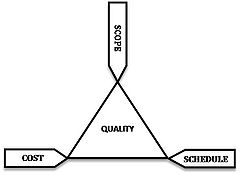
Project triangle
Encyclopedia
The Project Triangle in engineering
is a triangle model of project
. It is a graphic aid where the three attributes show on the corners of the triangle to show opposition. It is useful to help with intentionally choosing project biases, or analyzing the goals of your project. The constraints are analogous with the project management triangle
- in fact, it may be seen as an Evolutionary pressure
.
 As a project management
As a project management
graphic aid, a triangle can show time, resources, and technical objective as the sides of a triangle, instead of the corners. John Storck, a former instructor of the American Management Association
's "Basic Project Management" course, used a pair of triangles called triangle outer and triangle inner to represent the concept that the intent of a project is to complete on or before the allowed time, on or under budget, and to meet or exceed the required scope. The distance between the inner and outer triangles illustrated the hedge or contingency for each of the three elements. Bias could be shown by the distance. His example of a project with a strong time bias was the Alaska pipeline which essentially had to be done on time no matter the cost. After years of development, oil flowed out the end of the pipe within four minutes of schedule. In this illustration, the time side of triangle inner was effectively on top of the triangle outer line. This was true of the technical objective line also. The cost line of triangle inner, however, was outside since the project ran significantly over budget.
James P. Lewis suggests that project scope represents the area of the triangle, and can be chosen as a variable to achieve project success. He calls this relationship PCTS (Performance, Cost, Time, Scope), and suggests that a project can pick any three.
The real value of the project triangle is to show the complexity that is present in any project. The plane area of the triangle represents the near infinite variations of priorities that could exist between the three competing values. By acknowledging the limitless variety, possible within the triangle, using this graphic aid can facilitate better project decisions and planning and ensure alignment among team members and the project owners.
 Like any human undertaking, projects need to be performed and delivered under certain constraints. Traditionally, these constraints have been listed as "scope," "time," and "cost". These are also referred to as the "Project Management Triangle
Like any human undertaking, projects need to be performed and delivered under certain constraints. Traditionally, these constraints have been listed as "scope," "time," and "cost". These are also referred to as the "Project Management Triangle
," where each side represents a constraint. One side of the triangle cannot be changed without affecting the others. A further refinement of the constraints separates product "quality" or "performance" from scope, and turns quality into a fourth constraint.
The time constraint refers to the amount of time available to complete a project. The cost constraint refers to the budgeted amount available for the project. The scope constraint refers to what must be done to produce the project's end result. These three constraints are often competing constraints: increased scope typically means increased time and increased cost, a tight time constraint could mean increased costs and reduced scope, and a tight budget could mean increased time and reduced scope.
The discipline of Project Management is about providing the tools and techniques that enable the project team (not just the project manager) to organize their work to meet these constraints.
It is worthy to note that in the latest version of the PMBOK, PMI has done away with the project triangle, the reason for this is that a project has many more constraints to be observed other than the scope, the time, and the cost.
Engineering
Engineering is the discipline, art, skill and profession of acquiring and applying scientific, mathematical, economic, social, and practical knowledge, in order to design and build structures, machines, devices, systems, materials and processes that safely realize improvements to the lives of...
is a triangle model of project
Project
A project in business and science is typically defined as a collaborative enterprise, frequently involving research or design, that is carefully planned to achieve a particular aim. Projects can be further defined as temporary rather than permanent social systems that are constituted by teams...
. It is a graphic aid where the three attributes show on the corners of the triangle to show opposition. It is useful to help with intentionally choosing project biases, or analyzing the goals of your project. The constraints are analogous with the project management triangle
Project management triangle
The Project Management Triangle is a model of the constraints of project management. It is often used to illustrate that project management success is measured by the project team's ability to manage the project, so that the expected results are produced while managing time and cost.- Overview...
- in fact, it may be seen as an Evolutionary pressure
Evolutionary pressure
Any cause that reduces reproductive success in a proportion of a population, potentially exerts evolutionary pressure or selection pressure. With sufficient pressure, inherited traits that mitigate its effects - even if they would be deleterious in other circumstances - can become widely spread...
.
Overview

Project management
Project management is the discipline of planning, organizing, securing, and managing resources to achieve specific goals. A project is a temporary endeavor with a defined beginning and end , undertaken to meet unique goals and objectives, typically to bring about beneficial change or added value...
graphic aid, a triangle can show time, resources, and technical objective as the sides of a triangle, instead of the corners. John Storck, a former instructor of the American Management Association
American Management Association
The American Management Association , based in New York City, is a corporate training and consulting group that provides a variety of educational and management development services to businesses, government agencies and individuals. The non-profit membership organization offers business courses in...
's "Basic Project Management" course, used a pair of triangles called triangle outer and triangle inner to represent the concept that the intent of a project is to complete on or before the allowed time, on or under budget, and to meet or exceed the required scope. The distance between the inner and outer triangles illustrated the hedge or contingency for each of the three elements. Bias could be shown by the distance. His example of a project with a strong time bias was the Alaska pipeline which essentially had to be done on time no matter the cost. After years of development, oil flowed out the end of the pipe within four minutes of schedule. In this illustration, the time side of triangle inner was effectively on top of the triangle outer line. This was true of the technical objective line also. The cost line of triangle inner, however, was outside since the project ran significantly over budget.
James P. Lewis suggests that project scope represents the area of the triangle, and can be chosen as a variable to achieve project success. He calls this relationship PCTS (Performance, Cost, Time, Scope), and suggests that a project can pick any three.
The real value of the project triangle is to show the complexity that is present in any project. The plane area of the triangle represents the near infinite variations of priorities that could exist between the three competing values. By acknowledging the limitless variety, possible within the triangle, using this graphic aid can facilitate better project decisions and planning and ensure alignment among team members and the project owners.
Example
You are given the options of Fast, Good and Cheap, and told to pick any two. Here Fast refers to the time required to deliver the product, Good is the quality of the final product, and Cheap refers to the total cost of designing and building the product. This triangle reflects the fact that the three properties of a project are interrelated, and it is not possible to optimize all three – one will always suffer. In other words you have three options:- Design something quickly and to a high standard, but then it will not be cheap.
- Design something quickly and cheaply, but it will not be of high quality.
- Design something with high quality and cheaply, but it will take a long time.
Project Management Triangle

Project management triangle
The Project Management Triangle is a model of the constraints of project management. It is often used to illustrate that project management success is measured by the project team's ability to manage the project, so that the expected results are produced while managing time and cost.- Overview...
," where each side represents a constraint. One side of the triangle cannot be changed without affecting the others. A further refinement of the constraints separates product "quality" or "performance" from scope, and turns quality into a fourth constraint.
The time constraint refers to the amount of time available to complete a project. The cost constraint refers to the budgeted amount available for the project. The scope constraint refers to what must be done to produce the project's end result. These three constraints are often competing constraints: increased scope typically means increased time and increased cost, a tight time constraint could mean increased costs and reduced scope, and a tight budget could mean increased time and reduced scope.
The discipline of Project Management is about providing the tools and techniques that enable the project team (not just the project manager) to organize their work to meet these constraints.
It is worthy to note that in the latest version of the PMBOK, PMI has done away with the project triangle, the reason for this is that a project has many more constraints to be observed other than the scope, the time, and the cost.

